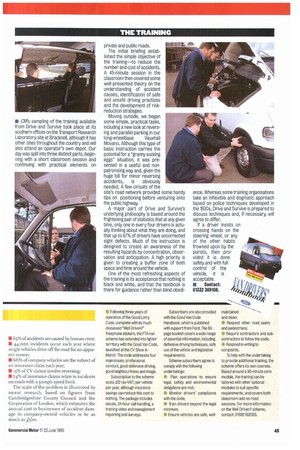In a change to our usual format, this month's vans page
Page 46

Page 47

If you've noticed an error in this article please click here to report it so we can fix it.
takes a look at training for van drivers. For the first time in many, many years, our man Colin Barnett went back to school... • CiVis sampling of the training available from Drive and Survive took place at its southern offices on the Transport Research Laboratory site at Bracknell, although it has other sites throughout the country and will also attend an operator's own depot. Our day was split into three distinct parts, beginning with a short classroom session and continuing with practical elements on
private and public roads.
The initial briefing established the simple objective of the training—to reduce the number and cost of accidents. A 45-minute session in the classroom then covered some well-presented theory on the understanding of accident causes, identification of safe and unsafe driving practices and the development of riskred uction strategies.
Moving outside, we began some simple, practical tasks, including a new look at reversing and parallel parking in our long-wheelbase Vauxhall Movano. Although this type of basic instruction carries the potential for a "granny sucking eggs" situation, it was presented in a useful and nonpatronising way and, given the huge bill for minor reversing accidents, is obviously needed. A few circuits of the site's road network provided some handy tips on positioning before venturing onto the public highway.
A major part of Drive and Survive's underlying philosophy is based around the frightening pair of statistics that at any given time, only one in every four drivers is actually thinking about what they are doing, and that up to 67% of drivers have uncorrected sight defects. Much of the instruction is designed to create an awareness of the resulting hazards by concentration, observation and anticipation. A high priority is given to creating a buffer zone of both space and time around the vehicle.
One of the most refreshing aspects of the training is its acceptance that nothing is black and white, and that the textbook is there for guidance rather than blind obedi
ence. Whereas some training organisations take an inflexible and dogmatic approach based on police techniques developed in the 1930s, Drive and Survive is prepared to discuss techniques and, if necessary, will agree to differ.
If a driver insists on crossing hands on the steering wheel, or any of the other habits frowned upon by the purists, then provided it is done safely and with full control of the vehicle, it is acceptable.
• Contact: 01332 309106.
















































































































